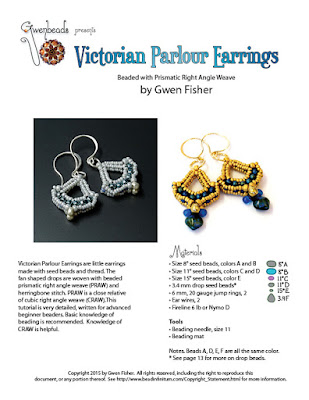I recently released my newest tutorial for a bangle bracelet. I called it the Tentacle Bangle because the way the embellishment looks reminds me of the suckers on a octopus' tentacle.
This tutorial explains how to bead weave a bracelet with one size of seed bead, round or bicone beads, and thread. No fancy shapes required! The Tentacle Bracelet is hollow and somewhat flexible. It is quite substantial, measuring 14 mm wide.
This tutorial includes step-by-step instructions for weaving the bracelet into a continuous bangle. This tutorial is designed for intermediate bead weavers. The tutorial is 12 pages, including about 75 illustrations and photographs. The tutorial is a PDF file that gives step-by-step instructions for the bracelet and earrings in the photos.
This design uses the honeycomb angle weave. It’s like right angle weave (RAW), but with other angles. If you like RAW and want a new challenge, you’ll love this. However, you don’t need to know RAW to follow this tutorial. This is my fifth tutorial using honeycomb weave. The first was the Daisy Chain Cable.
Second is the Delta Queen Necklace.
Third is the Honeycomb Chain Bracelet.
Fourth is the Solaris Bracelet.
And here you can see one last photo of the Tentacle Bracelet.
As you can see, honeycomb weave is a very versatile weave. Somehow, I think I'm not done designing with it yet. As always, thanks for looking.
This tutorial explains how to bead weave a bracelet with one size of seed bead, round or bicone beads, and thread. No fancy shapes required! The Tentacle Bracelet is hollow and somewhat flexible. It is quite substantial, measuring 14 mm wide.
This tutorial includes step-by-step instructions for weaving the bracelet into a continuous bangle. This tutorial is designed for intermediate bead weavers. The tutorial is 12 pages, including about 75 illustrations and photographs. The tutorial is a PDF file that gives step-by-step instructions for the bracelet and earrings in the photos.
This design uses the honeycomb angle weave. It’s like right angle weave (RAW), but with other angles. If you like RAW and want a new challenge, you’ll love this. However, you don’t need to know RAW to follow this tutorial. This is my fifth tutorial using honeycomb weave. The first was the Daisy Chain Cable.
Second is the Delta Queen Necklace.
Third is the Honeycomb Chain Bracelet.
Fourth is the Solaris Bracelet.
And here you can see one last photo of the Tentacle Bracelet.
As you can see, honeycomb weave is a very versatile weave. Somehow, I think I'm not done designing with it yet. As always, thanks for looking.





















